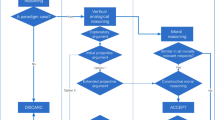Abstract
Although analogical reasoning has long been a popular method of reasoning in bioethics, current literature does not sufficiently grasp its variety. We assert that the main shortcoming is the fact that an analogy’s value is often judged on the extent of similarity between the source situation and the target situation, while in (bio)ethics, analogies are often used because of certain dissimilarities rather than in spite of them. We make a clear distinction between dissimilarities that aim to reinforce a similar approach in the source situation and the target situation and dissimilarities that aim to undermine or denounce a similar approach. The former kind of dissimilarity offers the analogy more normative force than if there were no dissimilarities present; this is often overlooked by authors who regard all relevant dissimilarities as detrimental to the analogy’s strength. Another observation is that an evaluation of the normative force of an analogy cannot be made independently of moral principles or theories. Without these, one cannot select which elements in an analogy are morally relevant nor determine how they should be interpreted.
Similar content being viewed by others
Notes
Note that although C. Shelley has developed the notion of ‘disanalogies’, they are not based on dissimilarities [6].
The most noteworthy attempt to determine which elements and relations are more likely to be relevant or irrelevant from a “neutral” perspective is that by Gentner, which basically rests on the idea that the more intertwined elements (or object-attributes) and relationships are, the more likely it is that they are also relevant [2].
Analogy 7 is not mentioned as it does not refer to any of the five principle arguments for and against payment for oocyte providers. Instead, it refers to the argument of altruism (as opposed to exploitation of a patient) in the debate regarding the payment of organ providers, which is not morally relevant here (as the analogy intends to show).
References
Hofmann, Bjørn, Jan Helge Solbakk, and Søren Holm. 2006. Teaching old dogs new tricks: The role of analogies in bioethical analysis and argumentation concerning new technologies. Theoretical Medicine and Bioethics 27: 397–413.
Gentner, Dedre. 1983. Structure-mapping: A theoretical framework for analogy. Cognitive science 7: 155–170.
Keane, Mark T., Tim Ledgeway, and Stuart Duff. 1994. Constraints on analogical mapping: A comparison of three models. Cognitive Science 18: 287–334.
Holyoak, Keith J., and Paul Thagard. 1995. Mental leaps: Analogy in creative thought. Cambridge, MA: MIT Press.
Alexander, Larry. 1989. Constrained by precedent. Southern California Law Review 63: 1–64.
Shelley, Cameron. 2002. The analogy theory of disanalogy: When conclusions collide. Metaphor and Symbol 17(2): 81–97.
Spar, Debora. 2007. The egg trade—Making sense of the market for human oocytes. New England Journal of Medicine 356: 1289–1291.
Norsigian, Judy. 2005. Egg donation for IVF and stem cell research: Time to weigh the risks to women’s health. Differentakes 33(Spring). http://popdev.hampshire.edu/sites/popdev/files/uploads/dt/DifferenTakes_33.pdf. Accessed 12 May 2010.
Seibel, Machelle M., and Ann A. Kiessling. 1993. Compensating egg donors: Equal pay for equal time? New England Journal of Medicine 328: 737.
Taylor, Ailsa. 2009. HFEA calls for debate around payment for sperm and egg donation. Bionews 518. http://www.bionews.org.uk/page_45715.asp. Accessed 12 May 2010.
President’s Council on Bioethics. 2003. Biotechnology and public policy: Professional self-regulation. Transcript of session 6 of the meeting of the President’s Council on Bioethics, Washington, DC, March 7. http://www11.georgetown.edu/research/nrcbl/pcbe/transcripts/march03/session6.html. Accessed 12 May 2010.
Dickenson, Donna. 2006. The lady vanishes: What’s missing from the stem cell debate. Journal of Bioethical Inquiry 3: 43–54.
Hyun, Insoo. 2006. Fair payment or undue inducement? Nature 442: 629–630.
Ethics Committee of the American Society for Reproductive Medicine. 2004. Financial incentives in recruitment of oocyte donors. Fertility and Sterility 82(S1): 240–244.
Ramsey, Joanne. 2007. Donating eggs for research—Should the HFEA reconsider its policy on payments to egg donors? Reproductive BioMedicine Online 15(S1): 25–33.
Gruen, Lori. 2007. Oocytes for sale? Metaphilosophy 38: 285–308.
Waldby, Catherine. 2008. Oocyte markets: Women’s reproductive work in embryonic stem cell research. New Genetics and Society 27(1): 19–31.
Reid, Lynette, R. Natalie Ram, and Blake Brown. 2007. Compensation for gamete donation: The analogy with jury duty. Cambridge Quarterly of Healthcare Ethics 16: 35–43.
Widdows, Heather. 2009. Border disputes across bodies: Exploitation in trafficking for prostitution and egg sale for stem cell research. International Journal of Feminist Approaches to Bioethics 2(1): 5–24.
Giacomini, Mita. 2005. One of these things is not like the others: The idea of precedence in health technology assessment and coverage decisions. The Milbank Quarterly 83: 193–223.
Sunstein, Cas R. 1993. On analogical reasoning. Harvard Law Review 106: 741–791.
Jonsen, Albert R. 1995. Casuistry: An alternative or complement to principles? Kennedy Institute of Ethics Journal 5(3): 237–251.
Arras, John D. 1991. Getting down to cases: The revival of casuistry in bioethics. The Journal of Medicine and Philosophy 16: 29–51.
Beauchamp, Tom L., and James F. Childress. 2008. Principles of Biomedical Ethics, 6th ed. New York: Oxford University Press.
Hunter, Dan. 2001. Reason is too large: Analogy and precedent in law. Emory Law Journal 50: 1215–1220.
Gillam, Lynn. 1997. Arguing by analogy in the fetal tissue debate. Bioethics 11: 397–412.
Mertes, Heidi, and Guido Pennings. 2007. Oocyte donation for stem cell research. Human Reproduction 22(3): 629–634.
Steinbock, Bonnie. 2004. Payment for egg donation and surrogacy. The Mount Sinai Journal of Medicine 71: 255–265.
Acknowledgments
The preparation of this article was supported by a grant from the Research Foundation––Flanders. We would also like to thank Joke Meheus and the reviewers of Theoretical Medicine and Bioethics for their remarks and suggestions.
Author information
Authors and Affiliations
Corresponding author
Rights and permissions
About this article
Cite this article
Mertes, H., Pennings, G. The force of dissimilar analogies in bioethics. Theor Med Bioeth 32, 117–128 (2011). https://doi.org/10.1007/s11017-010-9165-6
Published:
Issue Date:
DOI: https://doi.org/10.1007/s11017-010-9165-6




